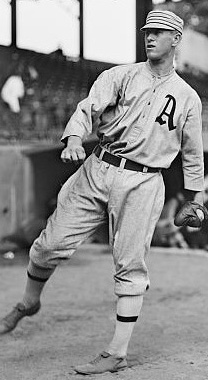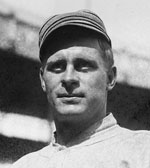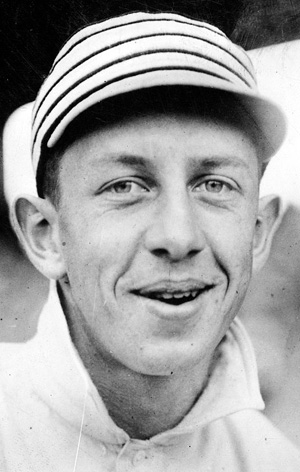|
Pivotal World Series Plays
"Two of the Most Astonishing Bonehead Plays"
1914 World Series - Game 3: Philadelphia Athletics @ Boston Braves
Their backs to the wall after losing the first two games at home, the Athletics played much better in the next game at Fenway Park, which the Braves had used rent-free from the Red Sox starting in August to accommodate larger crowds during their exciting stretch run.
A crowd of 35,520 – greater than any that had watched the Red Sox in the 1912 World Series – saw the A's take their first lead of the Series with a run in the first, but the Braves tied it in the bottom of the second. After each side plated a run in the fourth, starters Bullet Joe Bush for Philly and Lefty Tyler for Boston hung goose eggs on the board to send the game into extra innings. That set up an exciting tenth inning.
United Press reporter Hugh Fullerton, who would become nationally famous five years later with his observations of the tainted 1919 World Series, wrote in his article on the game, "The teams played wonderful and brainy ball, neither overlooking a chance, although the deciding moments during the rush and riot of the final innings were marked by two of the most astonishing bonehead plays ever seen."
    L-R: Bullet Joe Bush, Lefty Tyler, Hugh Fullerton, Johnny Evers Evers Freezes and Let Extra Run Score
The first bonehead play was committed by Johnny Evers who, as second baseman for the Cubs in 1908, noticed that Fred Merkle had not touched second on the apparent game-winning hit and retrieved the ball for a forceout as Giants fans rushed the field, causing the game to be declared a tie rather than a New York victory.
The top of the tenth began with A's C Wally Schang singling to left field. Pitcher Bush tried to sacrifice but bunted foul with two strikes for the first out. RF Eddie Murphy laid down a bunt. P Tyler fielded it and, rather than taking the sure out at first, threw to second too late to catch Schang, who had been running on the pitch. LF Rube Oldring smacked a hard one that bounced off Tyler's glove to Evers, who hurried a throw to first to nail the batter. 2B Eddie Collins was passed to fill the bases and bring up "Home Run" Baker.
Let Fullerton describe what happened next.
"Baker slipped a fierce bounder between second and first. Evers made a marelous try for the ball, reached it – almost choked off a basehit, but the ball struck him on the shoulder and fell dead and one run went home. In sheer excess of despair Evers grabbed the ball, held it in his hand and without looking toward the plate allowed the second runner to scamper home. It seemed as if Boston was beaten and Merkle was avenged. Johnny, the brainiest of them all, had blundered and allowed two runs to count where only one should have blossomed."
When Tyler got Stuffy McInnis to fly to center on his 25th pitch of the inning, the jubilant A's took the field thinking they would turn the tide with a victory.
    L-R: Wally Schang, Rube Oldring, Eddie Collins, Home Run Baker Collins Lines Up Wrong
Braves C Hank Gowdy smashed the first pitch from Bush to deep right center field where it bounced into the seats for a home run. After PH Josh Devore struck out, RF Herbie Moran drew a 3-2 walk. Evers stepped to the plate, anxious to cancel his mental error in the top of the inning. That's when A's 2B Eddie Collins commited Fullerton's second bonehead play. "Bush was pitching fast balls inside to Evers and decided to pitch a curve. Evers was set to hit and he drove a fierce low bounder right where Collins should have been playing for him with a curve being pitched." The single, Evers' third hit of the game, sent Moran to third.
Braves Tie Score
That brought up LF Joe Connolly, who had muffed a line drive right at him in the first inning to contribute to the A's first run. He lifted a high fly to CF Jimmy Walsh that drove home Moran with the tying run. The fans gave the Braves a five-minute ovation.
James Shuts Down A's
With twilight setting in, neither team threated in the eleventh, and RHP Bill James pitched his second scoreless inning in the top of the 12th.
The report in the Philadelphia Inquirer said this: "It was now so dark that the players experienced difficulty in seeing the ball, and Umpires Klem and Dineen, who had held a conference between the innings, had evidently agreed to call the game when the Braves had finished their turn at bat."
 Fenway Park during Game 3 of the 1914 World Series Notice the temporary bleachers in front of the left field wall. Mack Stays with Bush
Gowdy led off again. He was five-for-eight in the Series and had already walked, doubled, and homered off Bush. Yet Mack stayed with his starter. This time Hank slammed the ball into the left field bleacher seats for a ground rule double. Boston manager George Stallings made two changes. Les Mann pinch ran for Gowdy as Larry Gilbert pinch hit
for James. A's manager Connie Mack ordered Bush to walk Gilbert intentionally to set up a double play possibility or a forceout at third.
RF Herbie Moran stepped into the batter's box with a chance to give the Braves a commanding three games-to-none lead in the Series. That happened, but no one would think of Moran as a hero.
Wild Throw Sends Home Winning Run
He bunted down the third-base line. Bush fielded the ball cleanly, but instead of throwing to first, tried to nail Mann heading to third. The hurried throw sailed wild, allowing Mann to rush home with the deciding tally that made Bush the hard-luck loser.
The crowd carried the Braves off the field while the dejected Athletics made a beeline to their dressing room.
The "Miracle Braves" completed their incredible sweep the next day.
References
Boston's 100 Greatest Games, Rob Sneddon (2019) The Miracle Braves of 1914: Boston's Original Worst-to-First World Series Champions, Edited by Bill Nowlin (2014) |